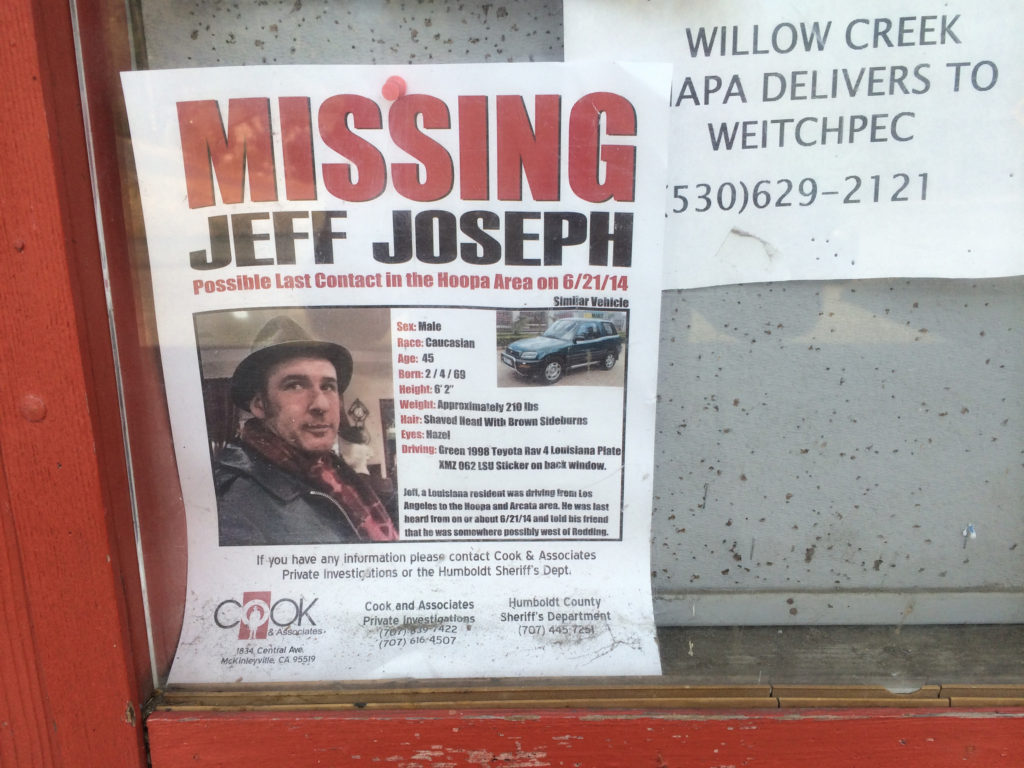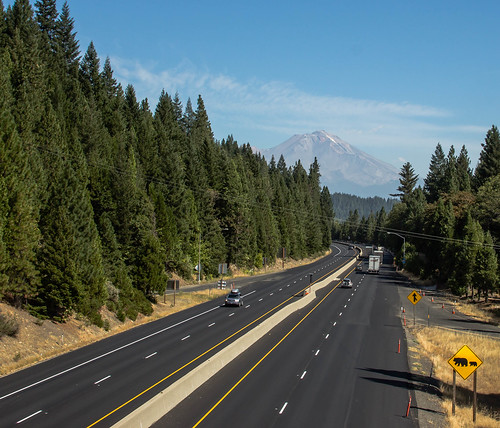
On Christmas Day, I experienced a burst of motivation to clean off my desk to make room for some new electronics. That’s a project that’s still under way. But one of the discoveries I made as I tried to excavate the workspace was the odd and not entirely lovely object above.
It’s a handcrafted flower, in case you’re wondering. Made from partially melted black plastic spoons spraypainted white. It was offered for sale by a man I encountered during a brief stop at the Humboldt County wayside of Weitchpec in August 2014.
How I got there was I had driven up to Lewiston Dam, northwest of Redding, for a ceremony by members of Native American tribes in the area. They had called on the federal Bureau of Reclamation to increase releases into the Trinity River to protect migrating chinook salmon that were at risk of disease or death because of low flows and warm water downstream on the Klamath River.
The bureau, in fact, ordered increased releases into the Trinity River before the ceremony. But I made the trip, met some people, drove to a motel in Redding, had dinner, and wrote a little story on a related court case.
I only had one other item on my agenda: a visit to Shasta Lake, California’s biggest reservoir, which was very low in late August because of the ongoing drought. But with no one breathing down my neck to get back to the Bay Area, I decided it would be good to see a little of the country I had been writing about. I’d head up Highway 299 from Redding and follow the Trinity River up to the Klamath, then follow the Klamath east to Interstate 5, just above Yreka. I’d spend the night back in Mount Shasta — at the end of a drive of about 300 miles.
For the first part of the drive, not much transpired. Just one beautiful scene after another. The Trinity, swollen with the “extra” water released from the dams up stream, looked high and a little wild. After turning north off 299 onto Highway 96 at Willow Creek, I drove through the Hoopa Valley, home of one of northwestern California’s larger native tribes.
North of Hoopa, Highway 96 narrows as it climbs a ridge on the south bank of the river and after a few twisting miles reaches Weitchpec. The settlement, part of the Yurok tribe’s reservation, is the proverbial wide spot in the road. On one side, a couple of homes and mailboxes for outlying residents. On the other side, a grocery and a couple of weathered manufactured homes on a lot that overlooks the spot where the Trinity flows into the Klamath. There was an old, badly lettered sign that offered smoked salmon for sale.
My visit was brief. At first, I overshot the grocery and drove across the bridge across the Klamath. “I’ve got to have a picture of this,” I thought, so I swung back around, recrossed the bridge and parked at the store. I walked back across the span and snapped a few pictures, then returned to the store and walked around back, where I guessed I’d have the best view of the confluence.
A man approached me when I started to take pictures — maybe the resident of one of the mobile homes. A short, spare older man. I thought maybe I’d be called for trespassing — fair enough — and I explained I just wanted to get a shot of the spot where the two rivers joined. He agreed it was a good view. When I was done shooting — it was just a minute or two — he asked if I like salmon. Yeah, I said. Do you have any for sale? He said not yet, but that in a few weeks there would be some.
He was holding a plastic flower, the same one pictured at the top of the post. He showed it to me and said, “I make these and sell them.” How much do you sell them for, I asked. “Ten dollars,” he said.
I took a look. Not something I wanted. But by this time, I had taken in the man’s outfit. One detail stood out. He was wearing a large rectangular belt buckle that said “FUCK” in large chrome letters. That struck me as weird, and I decided I needed to take the guy’s picture. I offered him twenty bucks for the flower, and then asked if he’d pose. He was glad to.

As we walked back to the parking lot in front of the store, I asked his name. “J.K.,” he said. Or maybe it was J.G. or K.G. I didn’t write it down and at the distance of more than two years I honestly can’t remember.
I asked whether he was from Weitchpec. He said he was from the area, but had lived in the Bay Area for years, working as a mechanic for United Airlines in San Francisco. He had been back in the community for several years, he said. I did not ask the question I should have asked, which is why his belt buckle said “fuck.”
I thanked him for the flower, then went into the store. There were a couple of other customers, buying ice and other supplies for what I thought might be a camping trip. I went back to my rented car and got ready to leave when I noticed a community bulletin board on the store’s outside wall.
I honestly only remember one posting: a flyer asking for help in locating a Southern California man who had gone missing in the area two months earlier.

I snapped a picture of the flyer. It’s a habit, growing out of curiosity about the missing and their stories.
But the outline of Jeff Joseph’s story — he had apparently come to this remote part of Humboldt County to grow marijuana for medicinal purposes — triggered a quick episode of paranoia.
Not that I was up there to grow pot, but here I was, a stranger to the area who had not told anyone where I’d be that day. I was driving a new-looking (though nothing fancy) rented car; I had shown my extravagant-looking (but not really expensive) camera around; I had pulled out my wallet and handed a guy a twenty like it was nothing. Gee — it would be easy for me to go missing, too, wouldn’t it, if someone tried to waylay me?
Nothing happened, obviously, beyond my sudden awareness that I could be vulnerable, too.
On my way up the Klamath on Highway 96, I encountered the Happy Camp Fire, the state’s biggest for 2014, burning the forest near the community of Seiad Valley. The fire was active the evening I was driving east toward Interstate 5, and I saw locals and fire crews watching the blaze send towering pyrocumulus clouds into the sky and torch big trees in the distance.
Eventually I made it out to the interstate, and before midnight I was in Mount Shasta, too late to get dinner but just a short drive from Shasta Lake and then a quick trip home. (The album at the end of the post shows some of the scenes I’ve described.)
Finding the plastic flower again earlier in the week made me look up Jeff Joseph again. He’s never been found.

